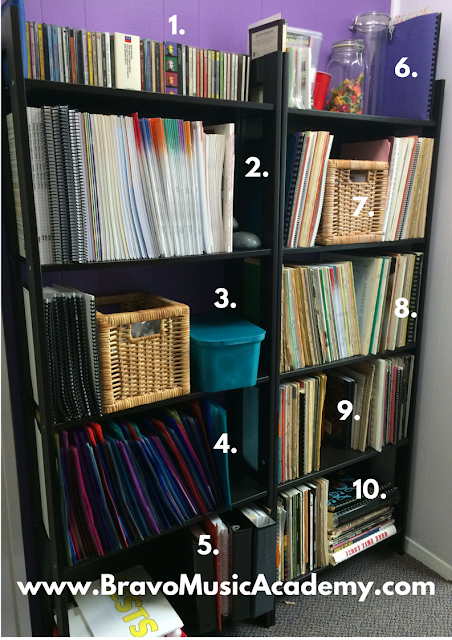In the process of writing this series on organization in the music studio, I've come to realize that I reorganize or rearrange my studio every few months. For the most part, the changes are small, but sometimes things need a complete overhaul. And in a way, I think it's a good thing. Every change I make helps me be a better teacher and leader.
I'm continually finding new resources and music for my students, who's needs are always changing. I'm adding resources for my teachers' use as well and we're both slowed down if they don't know how to find things without me.
1. CD's
There are three categories for my CD's: early childhood music, listening (classical & otherwise), and educational (ear training & music history). Within those categories, I arrange the CD's in alphabetical order by composer then performer last name.
2. New method books
Method books are sorted first by adult or child/teen classification. After that they're in alphabetical order by title then level.
3. Digital Prints, Game Supplies & Prize Box
I don't pre-print too much digital music simply because it's easy & quick enough to print and bind a book together during a student's lesson, so the books here are used mostly as previews.
I have 2 baskets of game supplies. These contain all extras I need; dice, rhythm tubes, plastic ponies, cars....you name it, I probably have it.
I posted about the prize box back in June (it was actually my 2nd post ever!).
4. Games
The majority of my games come from Andrea & Trevor Dow over at TeachPianoToday. I signed up for their Piano Game Club as soon as it started and it has been a lifesaver. They recommend storing your games in 2 pocket folders, but I was traveling when I first subscribed, so I needed something a little more secure. I store my games in these document folders.
5. Beat Bounce & Teacher Resources
Beat Bounce has a game-board that doesn't fit in the document folders, so it gets it's own special place in the library. :)
The teacher resources are primarily early childhood music activities and lesson plans.
6. Flashcards, Treats & Stickers
I think I may have a problem...You know those people who go out and buy a new shirt even though they already have the same one in 4 different colors? That's me with stickers and flashcards.
I use them so much and in so many different ways that I just keep ordering/downloading more.
I have ice cream, monster, penguin, winter, elephant & colorful rhythm, keyboard, note name, dynamic, tempo, & finger number flashcards.
I'm a former hardcore scrapbooker, so let's not even start on my sticker collection!
The treats in the canisters are used for the Music Symbol of the Week and as game pieces!
7. Theory, Game Supplies & Used Method Books
8. Supplemental Books: Technique & Repertoire
9. Ensemble music, Advanced Classical Books, Cups, Manuscript Paper, & Holiday Music
10. Vocal Music, Instrumental (other than piano), & Fake Books
All of the books on shelves 7, 8, 9, & 10 are part of the lending library.
When I started writing the business plan for the academy one of the first things I decided to include in tuition was access to a ever growing lending library. Registered students may borrow any book or CD at any time.
These shelves are organized like the new method books, first by title, then by level when appropriate.
~~~~~~~~~~~~~~~~~~~~~~~~~~~~~~~~~~~~~~~~~~~~~~~
I hope you've enjoyed this glimpse into my organizational strategies. Now it's your turn!
How do you organize your library? Do you keep music separate from everything else? Let me know in the comments! I'd love to see pictures of how you organize your music and supplemental activities. Share them here or on our Facebook page!

Love your organization. If I showed you my shelves, you would cry.
ReplyDelete